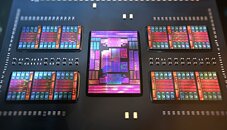- Joined
- Aug 19, 2017
- Messages
- 3,253 (1.13/day)
AMD's EPYC lineup already features the new Zen 4 core designed for better performance and efficiency. However, since the release of EPYC Milan-X processors with 3D V-cache integrated into server offerings, we wondered if AMD will continue to make such SKUs for upcoming generations. According to the report from Wccftech, we have a leaked table of specifications that showcase what some seemingly top-end Genoa-X SKUs will look like. The two SKUs listed here are the "100-000000892-04" coded engineering sample and the "100-000000892-06" coded retail sample. With support for the same SP5 platform, these CPUs should be easily integrated with the existing offerings from OEM.
As far as specifications, this processor features 384 MBs of L3 cache coming from CCDs, 768 MBs of L3 cache from the 3D V-Cache stacks, and 96 MBs of L2 cache for a total of 1248 MBs in the usable cache. A 3 MB stack of L1 cache is also dedicated to instructions and primary CPU data. Compared to the regular Genoa design, this is a 260% increase in cache sizes, and compared to Milan-X, the Genoa-X design also progresses with 56% more cache. With a TDP of up to 400 Watts, configurable to 320 Watts, this CPU can boost up to 3.7 GHz. AMD EPYC Genoa-X CPUs are expected to hit the shelves in the middle of 2023.

View at TechPowerUp Main Site | Source
As far as specifications, this processor features 384 MBs of L3 cache coming from CCDs, 768 MBs of L3 cache from the 3D V-Cache stacks, and 96 MBs of L2 cache for a total of 1248 MBs in the usable cache. A 3 MB stack of L1 cache is also dedicated to instructions and primary CPU data. Compared to the regular Genoa design, this is a 260% increase in cache sizes, and compared to Milan-X, the Genoa-X design also progresses with 56% more cache. With a TDP of up to 400 Watts, configurable to 320 Watts, this CPU can boost up to 3.7 GHz. AMD EPYC Genoa-X CPUs are expected to hit the shelves in the middle of 2023.

View at TechPowerUp Main Site | Source




